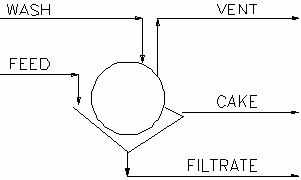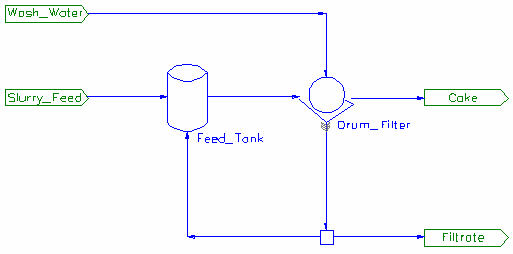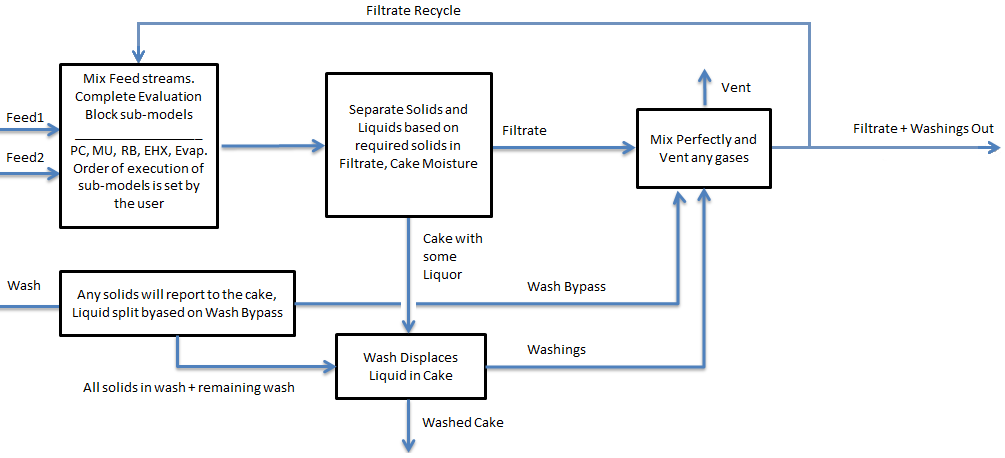Drum Filter
Navigation: Models ➔ Mass Separation Models ➔ Drum Filter
| Disk Centrifuge | Drum Filter | Filter Press | Belt Filter | Batch Centrifuge |
|---|---|---|---|---|
| No wash | Combined Filtrate only | With 1 optional Washings | With 2 optional Washings | |
General Description
The Drum Filter is used to separate the solids from the liquids in the feed stream. There is a facility to wash the solids using wash water. The wash water will displace some of the feed liquid from the cake. The washings will be combined with the filtrate, as there is no allowance for separate washings outlet.
Diagram
The diagram shows the default drawing of the Drum Filter, with all of the streams that are available for operation of the unit. The user does not have to connect a stream to the 'Wash Water' connection, as the Drum Filter will operate without wash water.
The physical location of the streams connecting to the Drum Filter is unimportant. The user may connect the streams to any position on the unit.
Inputs and Outputs
Label Required
OptionalInput
OutputNumber of Connections Description Min Max Feed 1 Required In 1 20 The slurry feed to the Drum Filter Wash Water Optional In 0 10 Wash water to the Drum Filter Filtrate Required Out 1 1 Filtrate outlet from the unit Cake Required Out 1 1 Solids outlet from the unit Vent Optional Out 0 1 Vent Stream (Vapour only).
Behaviour when Model is OFF
If the user disables the unit, by un-ticking the On tick box, then the following actions occur:
- All streams connected to the 'Feed' inlet will flow out of the 'Cake' outlet;
- All streams connected to the 'Wash Water' inlet will flow straight out of the 'Filtrate' outlet;
- No mixing will occur.
So basically, the unit will be 'bypassed' without the user having to change any connections.
Model Theory
The Drum Filter is based on user defined variables that define the solids / liquids split, as well as the efficiency of the washing action.
The user defines the amount of liquid in the filter cake and the amount of solids reporting to the filtrate. In addition, the user specifies the fractional bypass, which defines the fraction of the wash water that channels through the cake and reports directly to the filtrate. Obviously, if there is no wash water connected to the drum filter, then the user can ignore the washing variable.
For example, if the user defines a 0% fractional bypass, then all of the wash water is used to displace the filter feed liquid from the cake. If the fractional bypass is set at 20%, then 20% of the wash water will report directly to the filtrate stream without displacing any feed liquid from the solids.
NOTE: The model assumes no solids are present in the wash water stream. Any solids present will not be used in the Liq/Sol separation calculations. Furthermore, any solids present in the wash stream will be reported to the cake.
Example
The Drum Filter shown in the Diagram in 2 is configured to give 10% moisture in the cake, 1% of the feed solids in the filtrate, and 10% fractional bypass. The table below shows the material flows, in t/h, around the Filter Press with this configuration.
Material Feed Wash Water Cake Filtrate H2O(l) 8.0 0.9 0.97 7.93 NaCl(aq) 2.0 0.0 0.04 1.96 KCl(aq) 0.0 0.1 0.09 0.01 Total Liquid 10.0 1.0 1.1 9.9 Solids 10.0 9.9 0.1 Total Mass 20.0 1.0 11.0 10.0
This example shows that 10% of the wash water reported straight to the filtrate. The remaining 90% of the wash water, 0.9t/h, displaced an equal amount of feed liquid from the cake.
Internal Recycle of Filtrate
In Build 139 or later, a new option is included to calculate the required internal recycle of filtrate (which would include wash water) to dilute feed slurry to a user-defined solids concentration. This emulates the use of a feed tank or drum filter bath with filtrate recycle:
Flowchart
Note: The Filtrate Recycle option is only available in Build 139 or later.
Data Sections
The default access window consists of three sections:
- DrumFilter tab - Contains general information relating to the unit.
- PC - Optional tab that is visible if EB.Solubility.On is enabled on the first tab.
- RB - Optional tab, only visible if the Reactions are enabled.
- EHX - Optional tab, only visible if the EnvironHX is enabled.
- Evap - Optional tab that is visible if Evaporator is enabled.
- MU - Optional tab, or multiple tabs if more than 1 Makeup is selected. Only visible if one of more Makeup is enabled in the Evaluation Block.
- QFilterFeed - Available from Build 139. Optional tab, only visible if ShowTotalFeed is selected. This page shows the properties of the combined feed stream, including the internal recycle stream.
- This is before any Evaluation Block sub-models are evaluated.
- QCake - Available from Build 139. Optional tab, visible if ShowQCake is enabled. This and subsequent tab pages, e.g. QCake.. and Sp, shows the properties of the Cake stream. The tags in the QCake tab are valid even when the ShowQCake option is not selected.
- QFiltrate - Available from Build 139. Optional tab, visible if ShowQFiltrate is enabled. This and subsequent tab pages, e.g. QFiltrate.. and Sp, shows the properties of the Filtrate stream. The tags in the QFiltrate tab are valid even when the ShowQFiltrate option is not selected.
- Info tab - Contains general settings for the unit and allows the user to include documentation about the unit and create Hyperlinks to external documents.
- Links tab - contains a summary table for all the input and output streams.
- Audit tab - Contains summary information required for Mass and Energy balance. See Model Examples for enthalpy calculation Examples.
Drum Filter Page
Unit Type: DrumFilter - The first tab page in the access window will have this name.
| Tag (Long/Short) | Input / Calc | Description/Calculated Variables / Options |
| Tag | Display | This name tag may be modified with the change tag option. |
| Condition | Display | OK if no errors/warnings, otherwise lists errors/warnings. |
| ConditionCount | Display | The current number of errors/warnings. If condition is OK, returns 0. |
| GeneralDescription / GenDesc | Display | This is an automatically generated description for the unit. If the user has entered text in the 'EqpDesc' field on the Info tab (see below), this will be displayed here. If this field is blank, then SysCAD will display the UnitType or SubClass. |
Requirements | ||
| On | Tickbox | Switches on the filter operation. If this box is not selected, all the feed will report to the cake, all the wash will report to filtrate. |
| Filtrate_Method / Method | FiltrateSolidsFraction | User specifies the required filtrate % solids. |
| FiltrateConcentration | User specifies the filtrate solids concentration. | |
| FiltrateSolidFracReqd | Input | The required filtrate % solids - visible with FiltrateSolidsFraction method. |
| FiltrateSolidConc25Reqd | Input | The required filtrate solids concentration, measured at 25°C - visible with FiltrateConcentration method. |
| CakeMoistReqd | Input | The required percentage liquids in the filter cake. |
| WashBypass | Input | The required percentage of wash water that should bypass the filter cake, thus reporting directly to the filtrate stream. Note any solids in the wash water will be reported to the cake stream. |
| FiltrateSolidFracUsed | Calc | The actual filtrate % solids. |
Filtrate Recycle | ||
| RecycleFiltrate | Tick Box | Available from Build 139. Enables internal filtrate recycle. Additional fields will be displayed on this tab. |
| The following 2 fields are only visible if the RecycleFiltrate option has been enabled. Available from Build 139. | ||
| FeedSolidsConcReqd | Input | Target feed solids concentration. The internal filtrate recycle will be varied to try to achieve this concentration. |
| MaxFiltrateRecycle | Input | The maximum internal filtrate recycle. |
| OperatingP - NOTE: this pressure is applied to the (combined) feed, before sub-models (if any). | ||
| Method | AutoDetect | If there are any liquids AND no vapours present in the feed, outlet streams will take the highest pressure of the feeds. Else (e.g. some vapours present) outlet streams will take the lowest pressure of the feeds. |
| LowestFeed | Outlet streams will take the lowest pressure of the feeds. | |
| HighestFeed | Outlet streams will take the highest pressure of the feeds. | |
| Atmospheric | Outlet streams will be at Atmospheric Pressure. The atmospheric pressure is calculated by SysCAD based on the user defined elevation (default elevation is at sea level = 101.325 kPa). The elevation can be changed on the Environment tab page of the Plant Model. | |
| RequiredP | Outlet streams will be at the user specified pressure. | |
| IgnoreLowMassFlow / IgnoreLowQm | Tick Box | This option is only visible if the AutoDetect, LowestFeed or HighestFeed methods are chosen. When calculating the outlet pressure and temperature of the tank, SysCAD will ignore the low flow feed streams should this option be selected. The low flow limit is set in the field below. |
| LowMassFlowFrac / LowQmFrac | Input | This field is only visible if the IgnoreLowQm option is selected. This is the amount any stream contributes to the total flow. For example, if the total feed to the tank is 10 kg/s, and this field is set to 1%. Then any feed streams with less than 0.1 kg/s will be ignored in the pressure calculations. |
| PressureReqd / P_Reqd | Input | This field is only visible if the RequiredP method is chosen. This is user specified pressure. |
| Result | Calc | The actual pressure used for the sum of the feeds which will also be the outlet pressure (unless further model options change the pressure). |
EB (Flow Evaluation Block) | ||
| Solubility.On | Tickbox | Only visible if Solubility has been defined for at least one species in the project. Allows the user to switch on any predefined solubility curve to adjust the composition of material in the unit. |
| PhaseChange@T.On | Tickbox | Only visible if Phase Change at Temperature has been defined for at least one species in the project and Plant Model - Species Tab - PhaseChange@T = OFF. Allows the user to switch on any predefined phase changes at temperature in the unit. |
| EvalSequence | Calc | The sequence in which the sub models (which are part of the evaluation blocks) will be calculated. The sequence is determined by the priority selection for the individual sub-models. Note: If the user chooses On-AutoSequence then SysCAD will determine the sequence of the sub-models. The auto evaluation sequence followed will be the order the sub models are listed below. |
| Makeups | Input | The number of Makeup Blocks required. Extra dropdown options Makeup1, Makeup2, etc. will be added to allow these to be switched on and off and prioritised in relation to the other sub-models. |
| MakeupX | List | This can be used to switch the Makeup Block (MU) on or off and prioritise it in relation to the other sub-models. If this is 'On' then the associated page, MUX becomes visible and may be configured. Note: This field is only visible if the entry for 'Makeups' is greater than 0. If there is one makeup then X=1. If there are two makeups, then X=1 and X=2, etc. |
| Reactions | List | Reaction Block (RB) - Enable or disable Reactions and set the sequence in relation to the other sub-models. If this is 'On' then the associated page, RB becomes visible and may be configured. Note: The user does not have to configure a reaction file, even if this block is checked. |
| EnvironHX | List | Environmental Heat Exchanger (EHX) - Enable or disable Environmental Heat Exchange and set the sequence in relation to the other sub-models. If this is 'On' then the associated page, EHX becomes visible and may be configured. Note: The user does not have to configure an environmental heat exchange, even if this block is checked. |
| Evaporation | List | Evaporation Block (Evap) - Enable or disable the Evaporator and set the sequence in relation to the other sub-models. If this is 'On' then the associated page, Evap becomes visible and may be configured. Note: The user does not have to configure an evaporator, even if this block is checked. |
Options | ||
| TrackStatus | Tick Box | Allows warning messages be displayed if requirements are not met. |
| ShowQCake | Tickbox | Available from Build 139. When selected, the QCake and associated tab pages (e.g. Sp) will become visible, showing the properties of the Cake stream. See Material Flow Section. Tags in the QCake tab can be used for controllers (e.g.: PGM files) and reports even when this option is not selected. |
| ShowQFiltrate | Tickbox | Available from Build 139. When selected, the QFiltrate and associated tab pages (e.g. Sp) will become visible, showing the properties of the Filtrate stream. See Material Flow Section. Tags in the QFiltrate tab can be used for controllers (e.g.: PGM files) and reports even when this option is not selected. |
| ShowTotalFeed | Tick Box | Available from Build 139. Only visible if the RecycleFiltrate option has been enabled. QFilterFeed and associated tab pages (e.g. Sp) will become visible, showing the properties of the combined feed stream, including the internal recycle stream. See Material Flow Section. This will be prior to any sub-model (e.g. reactions) actions. |
Results | ||
| Cake.SolidFrac / Cake.Sf | Calc | The calculated percentage of solids in the filter cake. |
| Cake.SolidConc25 | Calc | The cake solids concentration measured at 25°C. |
| Filtrate.SolidFrac / Filtrate.Sf | Calc | The calculated percentage of solids in the filtrate. |
| Filtrate.SolidConc25 | Calc | The filtrate solids concentration measured at 25°C. |
| WashComponent / WashComp | Input | Choose Compound/species from the drop down list for the calculation of Wash efficiency on a concentration base. (OPTIONAL) |
| CompWashEfficiency / CompWashEff | Calc | The calculated wash efficiency based on component concentration.
WashEff = (Conc Feed - Conc Cake) / (Conc Feed - Conc wash) |
| The following 5 fields are only visible if the RecycleFiltrate option has been enabled. Available from Build 139. | ||
| SlurryDensToFilter | Calc | The slurry density of the feed to the filter, including the internal filtrate recycle. |
| Filtrate.RecycleFrac | Calc | The calculated fraction of filtrate that has been (internally) recycled. |
| Filtrate.RecycleQm | Calc | The calculated mass flow of filtrate that has been (internally) recycled. |
| Filtrate.RecycleQv | Calc | The calculated volume flow of filtrate that has been (internally) recycled. |
| FeedToFilter.SolidConc25 | Calc | The calculated solids concentration of total feed to the filter at 25°C, including the internally recycled filtrate. |
Adding this Model to a Project
Add to Configuration File
Sort either by DLL or Group:
| DLL: | Separation.dll |
→ | Units/Links | → | Separation: Filter - Drum Filter | |
| or | Group: | Mass Separation |
→ | Units/Links | → | Separation: Filter - Drum Filter |
See Model Selection for more information on adding models to the configuration file.
Insert into Project Flowsheet
| Insert Unit | → | Separation | → | Filter - Drum Filter |
See Insert Unit for general information on inserting units.


